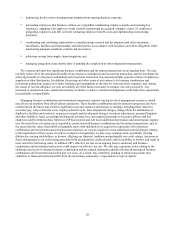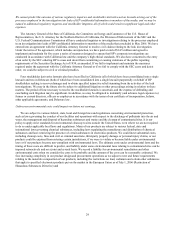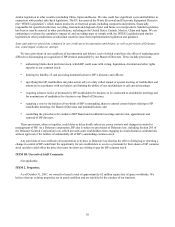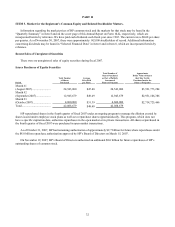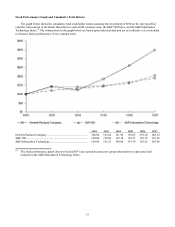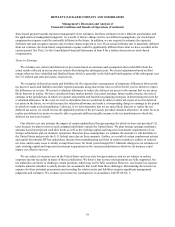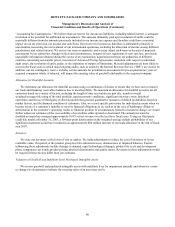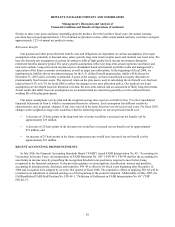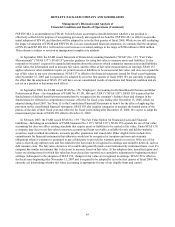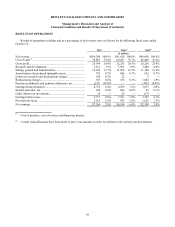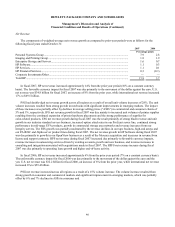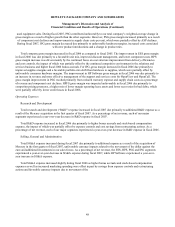HP 2007 Annual Report Download - page 52
Download and view the complete annual report
Please find page 52 of the 2007 HP annual report below. You can navigate through the pages in the report by either clicking on the pages listed below, or by using the keyword search tool below to find specific information within the annual report.HEWLETT-PACKARD COMPANY AND SUBSIDIARIES
Management’s Discussion and Analysis of
Financial Condition and Results of Operations (Continued)
between elements might impact the timing of revenue recognition but would not change the total revenue recognized on the
contract.
We recognize revenue as work progresses on certain fixed-price contracts, such as consulting arrangements. Using a
proportional performance method, we estimate the total expected labor costs in order to determine the amount of revenue
earned to date. We follow this basis because reasonably dependable estimates of the labor costs applicable to various stages
of a contract can be made. Total contract profit is subject to revisions throughout the life of the contract. We record changes
in revenue as a result of revisions to cost estimates to income in the period in which the facts that give rise to the revision
become known.
We record estimated reductions to revenue for customer and distributor programs and incentive offerings, including price
protection, promotions, other volume-based incentives and expected returns. Future market conditions and product transitions
may require us to take actions to increase customer incentive offerings, possibly resulting in an incremental reduction of
revenue at the time the incentive is offered. Additionally, certain incentive programs require us to estimate, based on
historical experience, the number of customers who will actually redeem the incentive.
Restructuring
We have engaged, and may continue to engage, in restructuring actions, which require management to utilize significant
estimates related to expenses for severance and other employee separation costs, realizable values of assets made redundant
or obsolete, lease cancellation and other exit costs. If the actual amounts differ from our estimates, the amount of the
restructuring charges could be materially impacted. For a full description of our restructuring actions, refer to our discussions
of restructuring in the Results of Operations section and Note 8 to the Consolidated Financial Statements in Item 8, which are
incorporated herein by reference.
Stock-Based Compensation Expense
Effective November 1, 2005, we adopted the fair value recognition provisions of Statement of Financial Accounting
Standards (“SFAS”) No. 123 (revised 2004), “Share-Based Payment” (“SFAS 123R”), using the modified prospective
transition method, and therefore have not restated prior periods’ results. Under this method, we recognize stock-based
compensation expense for all share-based payment awards granted after November 1, 2005 and granted prior to but not yet
vested as of November 1, 2005, in accordance with SFAS 123R. Under the fair value recognition provisions of SFAS 123R,
we recognize stock-based compensation expense net of an estimated forfeiture rate and recognize compensation cost for only
those shares expected to vest on a straight-line basis over the requisite service period of the award. Prior to SFAS 123R
adoption, we accounted for share-based payment awards under Accounting Principles Board Opinion No. 25, “Accounting
for Stock Issued to Employees” (“APB 25”) and, accordingly, generally recognized compensation expense only when we
granted options with a discounted exercise price.
Determining the appropriate fair value model and calculating the fair value of share-based payment awards require
subjective assumptions, including the expected life of the share-based payment awards and stock price volatility.
Management determined that implied volatility calculated based on actively traded options on HP common stock is a better
indicator of expected volatility and future stock price trends than historical volatility. Therefore, expected volatility in fiscal
years 2007, 2006 and 2005 was based on a market-based implied volatility. The assumptions used in calculating the fair
value of
38


